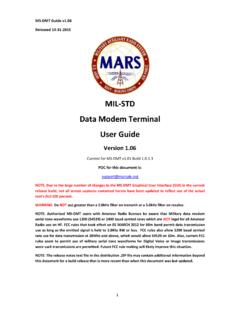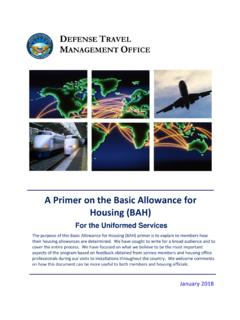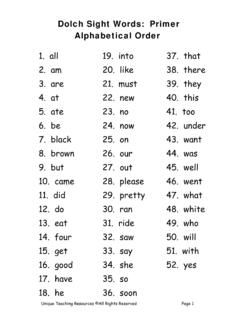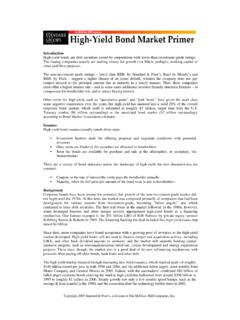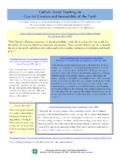Transcription of MIL-STD/STANAG Data Modem Primer - N2CKH
1 data Modem Primer MIL-STD/STANAG data Modem Primer Version POC for this document is: data Modem Primer ABSTRACT This document is written for the benefit of the MARS member in gaining a better understanding of Military and NATO HF data Modem standards. However the reading of this document is not required for the use of any hardware or software defined military Modem solutions applicable to support of the MARS mission. The majority of MARS members are Amateur Radio licensees which serves as a very good basis of HF radio knowledge and experience. An Amateur Radio license is also a prerequisite for becoming a MARS member. However, few Amateur Radio practices, equipment and digital modes intersect with MARS operational needs and the interoperable requirements of our MARS Military sponsors which are vastly different.
2 In addition data encryption is not authorized on the Amateur Radio bands. However when you are operating as a MARS member, you are operating as a DoD radio station. In that regard, in MARS the goal is that every digital transmission sent over the HF radio be encrypted for transmission to provide Operational Security (OPSEC). As such the data being handled by MARS may be sent in the clear as Plain Text (PT) or Encrypted Text (CT) and in the future by using Secure Voice (SV). The MARS primary mission is to provide contingency HF communications support to DoD and the Military Services. MARS also performs HF communications training with active duty, reserve and National Guard units.
3 The HF SSB transceiver predominately available to these units is the AN/PRC-150(C) HF-ALE tactical transceiver, where the new AN/PRC-160(V) is also now being fielded. It is a level of digital communications interoperability with these HF-ALE tactical transceivers that is a focus of MARS interoperability. As such the MARS member most strive to learn and be proficient in Military HF communications procedures and work to achieve interoperability to the Military Standards for both voice and digital communications in order to directly support the MARS mission. The purpose of this paper is to provide the MARS member with a better understanding of the Military digital waveforms detailed in both Military Standard (MIL-STD) and Standardized Agreement NATO ( stanag ) requirements as normally implemented in hardware based HF data Modems and HF Tactical Radios used by both MARS Military sponsors and MARS customers.
4 Also covered in passing for familiarity are data Link Protocol (DLP) based ARQ and Non-ARQ Multicast, Client/Server based HF e-mail, FAX and Digital Secure Voice use of these data Modem waveforms and where applicable how HF-ALE in both 2G and 3G implementations ties into the picture. Then too the use of in the clear and encrypted communications is brought into perspective. The Military waveforms data Modem standards, in particular MIL-STD-188-110A[1] (MS110A) Serial Tone (ST) waveforms, provide for Point-to-point and Point-to-multipoint communications in MARS directed Net operations and scheduled Broadcast application. MARS heavily relies upon the MS110A ST Forward Error Correction (FEC) coded 75bps through 2400bps data rates along with tactical chat header use for interoperability and data data Modem Primer encryption for OPSEC with use of MARS specific external terminal software applications without the use of ARQ overhead.
5 The Military HF waveforms of interest to MARS conform to a number of MIL-STD and stanag standards. In addition to the legacy MS110A serial tone coded waveforms, also of interest are the MIL-STD-188-110B[2] (MS110B) Appendix C waveforms providing throughput. In addition MIL-STD-188-110C[3] (MS110C) Appendix D 3kHz waveforms now being fielded in PRC-160(V) tactical radios and some COTS hardware Modem offerings will be of interest to MARS in the near future. Also of interest are stanag standards S4285[4], S4415[5] and S4539[7] where S4415 is a much more robust 75bps only standard as to Modem the receiver capability and is interoperable with MS110A at 75bps.
6 Although this document provides some level of technical details regarding many of the Military waveforms of interest. It does so for the purpose of a basic understanding of how the waveforms work and to explain the differences and enhanced features of the various waveforms in comparison for the benefit of the reader. The actual Modem waveform descriptions in their respective standard includes a complete specification of the modulation used and the known symbols used for initial training ( the preamble) to establish synchronization as well as any additional known symbols which may be inserted with the data ( the payload) to aid in ongoing synchronization or late entry and the demodulation process.
7 Also included are the details of forward error correction coding, bit redundancy and bit interleaving as an integral part of the definition. The referenced MIL-STD and stanag waveform documents herein combined with other Military standards which detail data Link Protocols (DLP) layers and Cryptography (CRYPTO) provide the specifications for Military communications systems by describing the on-the-air signaling used to transmit the digital data signal over a radio channel for intercept and decoding by the intended receiving station(s). data Modem Primer REFERENCES [1] MIL-STD-188-110A, INTEROPERABILITY AND PERFORMANCE STANDARDS FOR data MODEMS , 30 SEPTEMBER 1991 [2] MIL-STD-188-110B, INTEROPERABILITY AND PERFORMANCE STANDARDS FOR data MODEMS , 27 APRIL 2000 [3] MIL-STD-188-110C, INTEROPERABILITY AND PERFORMANCE STANDARDS FOR data MODEMS , 23 SEPTEMBER 2011 [4] NATO stanag 4285, CHARACTERISTICS OF 1200/2400/3600 BITS PER SECOND SINGLE TONE MODULATORS/DEMODULATORS FOR HF RADIO LINKS , BRUSSELS, EDITION 1, 17 FEBRUARY 1989 [5]
8 NATO stanag 4415, CHARACTERISTICS OF A ROBUST, NON-HOPPING, SERIAL-TONE MODULATOR/DEMODULATOR FOR SEVERELY DEGRADED HF RADIO LINKS", EDITION 1, 21 JUNE 1999 [6] NATO stanag 4529, CHARACTERISTICS FOR SINGLE TONE MODULATORS/ DEMODULATORS FOR MARITIME HF RADIO LINKS WITH 1240 HZ BANDWIDTHS , EDITION 1, 20 JANUARY 1998 [7] stanag 4539 C3 (EDITION 1), TECHNICAL STANDARDS FOR NON-HOPPING HF COMMUNICATIONS WAVEFORMS, 8 JUNE 2006 [8] FED-STD-1015 TELECOMMUNICATIONS: ANALOG TO DIGITAL CONVERSION OF VOICE BY 2400 BIT/SECOND LINEAR PREDICTIVE CODING, 11 AUGUST 1995 [9] FED-STD-1052 APPENDIX B, TELECOMMUNICATIONS: HF RADIO MODEMS , 7 AUGUST 1996 [10] FED-STD-3005 ANALOG-TO-DIGITAL CONVERSION OF VOICE BY 2,400 BIT/SECOND MIXED EXCITATION LINEAR PREDICTION (MELP), 20 December 1999 [11] stanag 5066 (EDITION 2)
9 , PROFILE FOR HF RADIO data COMMUNICATIONS, 5 DECEMBER 2008 [12] stanag 4197 EDITION 1, MODULATION AND CODING CHARACTERISTICS THAT MUST BE COMMON TO ASSURE INTEROPERABILITY OF 2400 BPS LINEAR PREDICTIVE ENCODED DIGITAL SPEECH TRANSMITTED OVER HF RADIO FACILITIES, 2 APRIL 1984 [13] stanag 4198 EDITION 1, PARAMETER AND CODING CHARACTERISTICS THAT MUST BE COMMON TO ASSURE INTEROPERABILITY OF 2400 BPS LINEAR PREDICTIVE ENCODED DIGITAL SPEECH, 13 FEBRUARY 1984 [14] stanag 4481 EDITION 1, MINIMUM TECHNICAL STANDARDS FOR NAVAL HF SHORE-TO-SHIP BROADCAST SYSTEMS, 19 JULY 2002 data Modem Primer [15] stanag 4591 EDITION 1, 600 BIT/S, 1200 BIT/S AND 2400 BIT/S NATO INTEROPERABLE NARROW BAND VOICE CODER, 3 OCTOBER 2008 [16] stanag 4203 C3 (EDITION 3), TECHNICAL STANDARDS FOR SINGLE CHANNEL HF RADIO EQUIPMENT, 27 APRIL 2007, ANNEX B and ANNEX C.
10 [17] MIL-STD-188-141C, INTEROPERABILITY AND PERFORMANCE STANDARDS FOR MEDIUM AND HIGH FREQUENCY RADIO SYSTEMS, 25 July 2011 [18] MIL-STD-188-141B, Interoperability and Performance Standards for Medium and High Frequency Radio Systems, Notice 1, 31 August 2001; Appendix C Third-Generation HF Link Automation. [19] stanag 4538 (EDITION 1) - TECHNICAL STANDARDS FOR AN AUTOMATIC RADIO CONTROL SYSTEM (ARCS) FOR HF COMMUNICATION LINKS, 24 February 2009 [20] ACP-142(A) - P_MUL - A PROTOCOL FOR RELIABLE MULTICAST IN BANDWIDTH CONSTRAINED AND DELAYED ACKNOWLEDGEMENT (EMCON) ENVIRONMENTS, October 2008 [21] ACP-127(G) COMMUNICATIONS INSTRUCTIONS TAPE RELAY PROCEDURES, NOVEMBER 1988 [22] MIL-STD-187-721C, INTERFACE AND PERFORMANCE STANDARD FOR AUTOMATED CONTROL APPLIQUE FOR I-IF RADIO, 30 NOVEMBER 1994, APPENDIX A, USAISEC TECHNICAL REPORT HF data LINK PROTOCOL [23] ARINC (Aeronautical Radio, Inc.)

